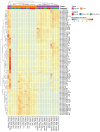MicroRNA Expression Profiling in Porcine Liver, Jejunum and Serum upon Dietary DON Exposure Reveals Candidate Toxicity Biomarkers
- PMID: 34769473
- PMCID: PMC8585098
- DOI: 10.3390/ijms222112043
MicroRNA Expression Profiling in Porcine Liver, Jejunum and Serum upon Dietary DON Exposure Reveals Candidate Toxicity Biomarkers
Abstract
Deoxynivalenol (DON), a frequent mycotoxin worldwide, impairs human and animal health. The response of microRNAs, small non-coding RNAs, to DON has been scarcely investigated, but holds remarkable potential for biomarker applications. Hence, we aimed to investigate DON-induced changes in the microRNA expression in porcine liver, jejunum and serum by combining targeted and untargeted analyses. Piglets received uncontaminated feed or feed containing 900 µg/kg and 2500 µg/kg DON for four weeks, followed by a wash-out period. In tissue, only slight changes in microRNA expression were detected, with ssc-miR-10b being downregulated in liver of DON-exposed piglets. In serum, several microRNAs were differentially expressed upon DON exposure, four of which were validated by qPCR (ssc-miR-16, ssc-miR-128, ssc-miR-451, ssc-miR-205). The serum microRNA response to DON increased over time and declined after removal of contaminated diets. Receiver operating curve analyses for individual microRNAs were significant, and a combination of the four microRNAs increased the predictive capacity for DON exposure. Predicted microRNA target genes showed enrichment of several pathways including PIK3-AKT, Wnt/β-catenin, and adherens junctions. This study gives, for the first time, a comprehensive view of the porcine microRNA response to DON, providing a basis for future research on microRNAs as biomarkers for mycotoxins.
Keywords: biomarker; deoxynivalenol; microRNA; mycotoxin; next generation sequencing.
Conflict of interest statement
M.S.-W., S.I., B.G. and V.N. are employed by BIOMIN Holding GmbH, which operates the BIOMIN Research Center. M.H. is the co-founder of TAmiRNA and employed by this company. This, however, did not influence the design of the experimental studies or bias the presentation and interpretation of results. The funders (Austrian Research Promotion Agency) had no role in the design of the study; in the collection, analyses, or interpretation of data; in the writing of the manuscript, or in the decision to publish the results.
Figures






References
-
- Pestka J.J. Deoxynivalenol: Toxicity, Mechanisms and Animal Health Risks. Anim. Feed Sci. Technol. 2007;137:283–298. doi: 10.1016/j.anifeedsci.2007.06.006. - DOI
-
- Pestka J. Toxicological Mechanisms and Potential Health Effects of Deoxynivalenol and Nivalenol. World Mycotoxin J. 2010;3:323–347. doi: 10.3920/WMJ2010.1247. - DOI
MeSH terms
Substances
Grants and funding
LinkOut - more resources
Full Text Sources
Other Literature Sources

